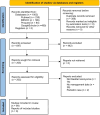Characteristics and outcomes in bladder Leiomyoma management: a systematic review of case reports and case series from the past 20 years
- PMID: 39538239
- PMCID: PMC11562614
- DOI: 10.1186/s12894-024-01624-3
Characteristics and outcomes in bladder Leiomyoma management: a systematic review of case reports and case series from the past 20 years
Abstract
Introduction: Bladder leiomyomas (LM) are uncommon, non-cancerous growths that originate from the smooth muscle cells of the bladder and constitute 0.5% of bladder tumor cases. This review aims to compile existing data and present a summary of bladder leiomyomas' characteristics, management, and related outcomes.
Method: We conducted systematic review of studies that investigated bladder leiomyoma. Case studies or series describing individuals with bladder leiomyoma who underwent surgery and the outcomes were included. Four databases were used in our literature search, which was carried out until January 2024: PubMed, Proquest, EBSCOHost, and Google Scholar. We utilized MeSH terms such as "leiomyoma," "urinary bladder," and looked for synonyms of "bladder leiomyoma" in free text.
Results: A total of 99 studies with 119 patients were included. Most reported bladder leiomyoma cases were female, accounting for 79.0% of all cases. While symptomatic patients primarily presented with lower urinary tract symptoms (LUTS) (59.7%), hematuria (24.4%), acute urine retention (11.8%), and about 16.8% of cases were incidentally detected. Storage-related symptoms were the most common LUTS (37.0%). Different diagnostic techniques were used, frequently combining CT (Computed Tomography), MRI (Magnetic Resonance Imaging), USG (Ultrasonography), and/or cystoscopy. Bladder leiomyomas were commonly found on the left lateral wall (26.9%) and the bladder neck (17.6%). In more than half of the cases (52.1%) the treatment techniques used were transurethral resection (TURBt/TUR). Fifteen out of 119 cases (12.6%) had recurrence or remain symptomatic. Symptomatic symptoms at first presentation and extended location are frequently found among recurrent or symptomatic cases after first management.
Conclusion: Management of bladder leiomyoma should focus on the relief of symptoms and recurrence and be personalized based on the tumor characteristics, patient symptoms, and surgeon's expertise. Further investigation is necessary to fully understand the best course of treatment and long-term results for bladder leiomyomas. In particular, prospective trials with bigger participant pools and meticulously controlled factors should be the main emphasis of this research.
Keywords: Bladder leiomyoma; Bladder neoplasm; Clinical characteristics; Management; Outcome of treatment.
© 2024. The Author(s).
Conflict of interest statement
Similar articles
-
Recurrent bladder leiomyoma: a case report.J Med Case Rep. 2024 Mar 22;18(1):173. doi: 10.1186/s13256-024-04372-y. J Med Case Rep. 2024. PMID: 38515215 Free PMC article.
-
Smooth muscle neoplasms of the urinary bladder: a clinicopathologic study of 51 cases.Am J Surg Pathol. 2010 Apr;34(4):502-9. doi: 10.1097/PAS.0b013e3181cf326d. Am J Surg Pathol. 2010. PMID: 20154594
-
Dual treatment approach for leiomyomas of urinary bladder: Experience from tertiary hospital.Int J Surg Case Rep. 2024 Oct;123:110316. doi: 10.1016/j.ijscr.2024.110316. Epub 2024 Sep 18. Int J Surg Case Rep. 2024. PMID: 39299196 Free PMC article.
-
[Leiomyoma of the urinary bladder: report of three cases].Hinyokika Kiyo. 2003 Nov;49(11):671-4. Hinyokika Kiyo. 2003. PMID: 14719456 Review. Japanese.
-
Bladder leiomyoma presenting as dyspareunia: Case report and literature review.Medicine (Baltimore). 2016 Jul;95(28):e3971. doi: 10.1097/MD.0000000000003971. Medicine (Baltimore). 2016. PMID: 27428187 Free PMC article. Review.
References
-
- Jhaveri PN, Makwana SV, Oza KK, Shah C. A histopathological study of urinary bladder neoplasms. Indian J Pathol Oncol. 2021;8(1):59–63.
-
- Hsiao CW, Sun GH, Wu ST, Chang SY, Yu DS. Leiomyoma of the bladder causing ureteral outlet obstruction: a case report and review of the literature. J Med Sci. 2000;20(7):377–82.
Publication types
MeSH terms
LinkOut - more resources
Full Text Sources
Medical
Miscellaneous


